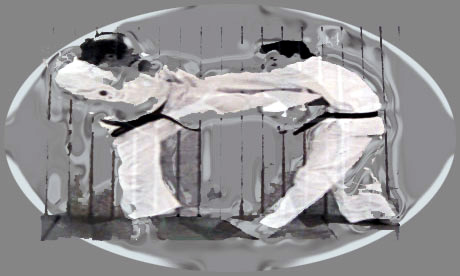

Roundhouse kick is noted as one of the most powerful kicks in Tae Kwon Do. What gives this kick its punch? The circle provides the answer. Angular momentum from the circular trajectory gives this kick extra force. Also, the body dynamics, where the lower body swings around with the kick, contribute to its power. The principle of the circle has profound philosophical meaning in Oriental Philosophy. The idea of infinite flow, ever-changing yet the same, gives it an elusive meaning. The roundhouse kick utilizes this principle. Unlike front kick and side kick which are both straight-line attacks, roundhouse is performed in a circle to sweep elusively around the opponent's defense. It flows relentlessly around obstacles, like water, which always prefers to be rounded when not conforming to a container's shape. Variations of roundhouse kick make it versatile and difficult to predict. Front roundhouse and snap roundhouse come in at different angles which adds surprise to the Tae Kwon Doist's arsenal.
Types of Roundhouse: The Full Thrust
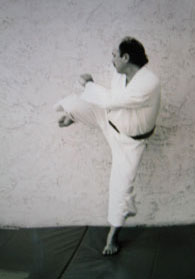 |
|
|
| 1, 2, 3- The full thrusting roundhouse kick begins from front stance. The rear leg lifts and sweeps around a full 180 degrees to kick. | ||
The full thrust roundhouse is the strongest of all the roundhouse kicks. It can be used in self defense because of its powerful penetrating quality. Practitioners who train this kick well can learn to break thick stacks of wood with this dynamic kick. Many powerful knockouts are brought about in kickboxing with the roundhouse thrust kick. Stand in a front stance. Raise your back leg, bending at the knee, so that your lower leg is parallel to the floor. As you pivot on your standing foot, swing your hips around and arc your kicking leg in a 180 degree circle, as you straighten to hit with the ball of the foot. The foot should be extended with the toes pulled back so that your toes are protected when you connect. To complete the kick, bend your leg again and pull it back in. This way you keep balance and control to move either forward or back following the kick. You will also lessen the chance for an opponent to trap your kick and throw you over or put you in a leg lock.
Front Snap Roundhouse
The front snap kick is the jab of leg techniques. The kick, which comes from the front leg, is extremely quick. Even though it has less power than the full roundhouse, the front snap roundhouse often surprises the opponent, which can set up a powerful finishing blow. Bill Wallace used this kick extensively during his undefeated career. Standing in back stance, lift your front leg with knee bent and foot held outwards. Make a quick circular movement of the hips as you extend your leg from the knee. The ball of the foot or the instep can be used for this kick. There are some styles, such as Bando and Thai Boxing, which prefer to kick with the instep or shin when they perform a roundhouse. In order to do this successfully, they devote a great deal of careful training time to body toughening. The ball of the foot is stronger, but the instep can be toughened to take the force. Tae Kwon Doists usually reserve the strongest roundhouse for the ball of the foot, because that part of the foot is hard, has a small surface area, and can penetrate the target. In sparring, with protective equipment, the instep may probably be used with less toughening required.
Knee Roundhouse
For closer ranger applications, the knee roundhouse is very effective. It is more likely to be used as a self defense move than a tournament technique since knees and elbows are illegal in most tournaments. This is because of it's devastating power, which can do damage if placed correctly. Begin in front stance and swing the leg up as you did in rear thrust roundhouse. Swing your hip around, but keep the knee bent. The area above your knee will be the striking point, effectively directed to the opponent's solar plexus.
Other Variations
The front snap
and rear thrust roundhouse kicks can be altered and combined to give you many
variations. You can perform a back snap roundhouse kick to fool your opponent.
The trajectory of this kick is a little different from the rear thrust which
makes it difficult for an opponent to predict. The leg position following this
kick, with knee bent, leads to many possible secondaries, such as hook kicks,
crescents, or another roundhouse. Stand in front stance, bring your back leg
up, but keep it bent behind you. Pivot on the standing foot, bring your knee
through, and then, as you turn, rotate your hip, then snap the kick out from
the knee in an arc. You can follow your opponent with this kick if he retreats.
Spinning roundhouse is another fun variation. You have probably seen spinning
roundhouse performed dramatically in movies like Sidekicks or Best of the Best.
After you throw a rear roundhouse kick, place your foot down in front, but toe
in. Continue to flow in the same direction as the kick to turn 360 degrees to
face front again. Immediately perform a second roundhouse kick with the same
foot just as you come out of the spin. These kicks are very fast and look impressive.
They sweep a wide circle clear, while being deceptive as to their exact target.
Groundhouse kick is an elusive way to dodge the opponent's high kick with a
surprising counter. As the opponent kicks, drop down to one knee and and duck
to the side under the opponent's kicking attack. You can place one hand on the
floor for added support. Raise your bend knee with the other foot and arc in
a roundhouse. As you retract the foot, push up with your hand to land in a balanced
stance. Remember to keep the other hand in front of your head to block.
Training Drills
The most basic
drill is to kick regularly and repeatedly. The practitioner may want to hold
on to a support at counter height so that control can be exercised in slower
motion. A doorway may be used as well. Slow and medium speed kicks help to train
the muscles. Pay close attention to the motion and concentrate. Exact positioning
and placement are essential for the best use of this kick. Slow repetitions
of extended leg swings in the doorway will add to your power and flexibility
for this kick. Try sets of ten reps to start. Performing basics in succession,
alternating the legs, also develops a fast and powerful kick. Each of the techniques
can be done in this way. Front stance is commonly used for this, but there is
no reason to limit the practice to this , since you may need to kick from other
stances in application. A brisk rhythm can be achieved in this way which is
very challenging. The ground is another helpful angle in training, Perform the
kick from various positions on the ground, Lying on your side restrains the
hips so that you develop the muscles used for proper motion in roundhouse kick.
Your sensei or perhaps a trusted partner can give you feedback and guide you
in performing correct form. Hips must be flexible for the roundhouse kick. General
exercises which strengthen and help to make the hips limber also help, such
as leg scissors and side lifts from the ground. Stretch carefully before and
after each workout. A good roundhouse kick feels good at the hip, so don't permit
excess tension to interfere. If it feels tight, you may want to correct your
technique. Finally, performing the roundhouse knee kick as a basic in repetitions
will help to strengthen the regular roundhouse as well. The hip motion is primary
in this kick, thus it is worthwhile as a general exercise even if the actual
technique is not performed. Work with a partner to polish your timing and accuracy.
To practice your rear roundhouse kick, face your partner in a left front stance
while he stands in right front stance. Trade kicks (no contact) to high, medium,
and lower targets. Do not block, but hold your hands in blocking position so
that you can practice kicking around the defense. For front roundhouse practice,
partners face each other in left backstance. Trade front roundhouses with the
right foot. In both of these exercises, switch stance to work out the other
leg.
Techniques
|
7, 8- The circular motion of roundhouse kicks makes them effective counterkicks. As the opponent punches the defender steps outside and then fires in a quick front roundhouse to the opponent's open midsection.
9, 10- Roundhouse kicks work well in kick combinations. The defender blocks the attackers front kick with an outer crescent. Then he retracts his leg and executes a roundhouse kick. |
There
are many counterattacking roundhouse
kick
techniques. As a counterattack, roundhouse kicks can loop in unexpectedly
around the opponent's attack. As the opponent charges with an
upper target reverse punch, you
can step evasively inside or outside to be in position to send your roundhouse
kick to a target area such as the stomache, usually wide open. Be careful:
you may need to protect your partner from charging into your kick. The same
concept works with a front kick attack from the opponent. Step quickly to
the outside as you block the kick away, perhaps with a crescent kick. Then
use your front roundhouse kick to score a point to the midsection. For a
self defense application, you can use a roundhouse shin kick to block the
opponent's low to middle target front and side kicks. To perform these comfortably,
you will need to do some shin conditioning. |
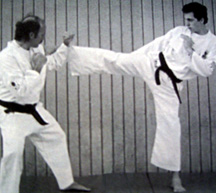 |
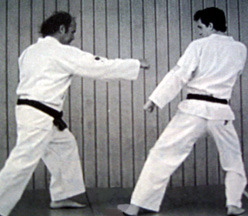 |
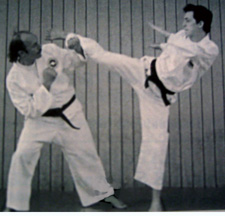 |
| 15, 16, 17- The spinning roundhouse is evasive and effective. The practitioner throws a high roundhouse kick, which is blocked. When the opponent attempts to counterpunch, the practitioner spins away to avoid the punch, then flows directly into a spinning roundhouse kick which blasts through the opponent's defense. | ||
Attack combinations can either begin or end with a roundhouse kick. Move the opponent's block up with a front jab reverse punch, then follow with a rear leg roundhouse kick to the middle target for a strong finish. A front kick fake can create an opening for your roundhouse kick. Skip in with a crosstep and perform a low front kick. This brings down the opponent's guard. Then perform an upper target roundhouse kick. A series of roundhouse kicks can be very difficult to block. Begin with a rear roundhouse kick to the upper target. The opponent will dodge back. As he tries to counterpunch, step in the direction of the counter, toe-in, and perform a secondary spinning roundhouse kick. Always be ready to follow up with hand or foot techniques such as spinning back kick or spinning backfist. Roundhouse works well in flowing combinations, for a circle has no begining and no end. With elusive circular power, your roundhouse kick will unerringly find its target!
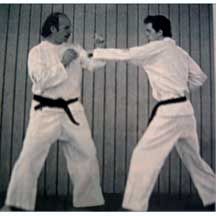 |
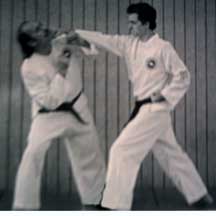 |
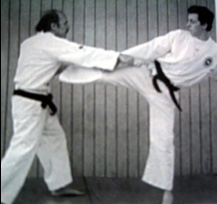 |
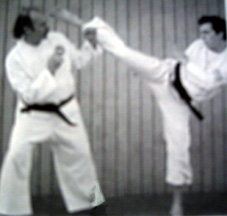 |
| 11, 12, 13, 14-Attack combinations using hands and feet can be very effective. The attacker punches twice to get the defender moving back. Next he uses a high thrust roundhouse kick to move the opponent's guard up. As the opponent tries to counterpunch, the alert attacker scores with a middle target roundhouse kick. | |||
Back
to Main Page / Interesting
Links / Book
Corner / Photos
/ Events /
E-mail us